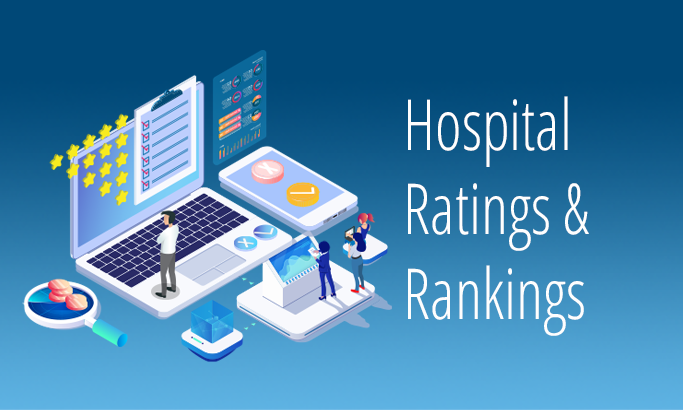Hospital Ratings and Rankings: You Are What Your Data Says You Are

There’s an old adage in sports that says you are what your record says you are. No matter what you think, your team is no better or no worse than its win/loss record. And as you’ve no doubt noticed as a hospital quality leader, in addition to it being baseball season, it’s also hospital ratings and rankings season.
Over the past few months, a number of organizations have issued their latest—and in some cases, their first—annual ratings and rankings of the nation’s hospitals. Each rating and ranking uses different criteria, but they do have one thing in common: data. All are based on data that your quality department either directly or indirectly submits to each of the organizations.
That means three things for you as a quality leader:
- Your hospital’s rating or ranking on each organization’s list is ultimately your responsibility
- Because it’s your responsibility, your data must accurately reflect your hospital’s performance
- Not taking that responsibility seriously could put your hospital’s credibility and reputation at risk
Consider a recent investigative reporting series in the New York Times. The series revealed case after case of poor-quality care at nursing homes that, despite that, were awarded a five-star rating by CMS (the highest rating possible). How did these nursing homes earn a top rating? According to the NYT series, it was the data: inaccurate, inflated and self-reported by the nursing homes.
It's better to give your hospital a competitive advantage in the market with high ratings and rankings backed up by accurate data than give yourself a black eye with an unflattering headline.
Let’s look at some of the data requirements and sources from five of the most recent hospital ratings and rankings.
CMS Hospital Star Ratings
On April 28, CMS released its latest annual star ratings for 3,355 hospitals using a new ratings methodology. CMS uses more than 100 performance measures pulled from data that hospitals submit to various CMS quality reporting programs and assigns them to one of five weighted measure groups: mortality, safety, readmission, patient experience, and timely and effective care. The average number of measures submitted by each hospital is 37, according to CMS. More than 1,400 hospitals, or 43% of the total hospitals rated, earned four or five stars under the new methodology.
Leapfrog Group Hospital Patient Safety Grades
On April 29, the employer-supported Leapfrog Group released its latest annual spring hospital patient safety grades. More than 2,700 hospitals voluntarily submitted data to the program. The Leapfrog Group assigns a letter grade to each hospital based on 27 different performance measures that it separates into two equally weighted domains: process measures and outcomes measures.
Fortune/IBM Watson Health 100 Top Hospitals
On April 27, Fortune and IBM Watson Health released their latest annual list of the 100 Top Hospitals. Analysts from Fortune and IBM gather performance data from three sources: Medicare cost reports, the Medicare Provider Analysis and Review database, and CMS’ Hospital (Care) Compare website. This data is teased into five domains—clinical outcomes, operational efficiency, patient experience, financial health and community health—to evaluate 2,675 hospitals. The top 100 hospitals make the final list. The community health domain is new this year.
Fortune and IBM also simultaneously released a 60 Top Community Hospitals list and a 15 Top Health Systems list.
Lown Institute Hospital Index
On May 4, the Lown Institute released its first-ever ranking of hospitals based on their overuse of low-value medical services. The overuse ranking is a spinoff from Lown’s annual Hospital Index. To come up with this new ranking, Lown analyzed Medicare fee-for-service claims data from more than 3,100 hospitals that performed 12 low-value medical services from 2016 through 2018. Low value means the service provides little or no therapeutic value to patients based on the latest medical research. Lown released a ranked top 50 list of hospitals that did the best job avoiding low-value services, and a ranked bottom 50 list of hospitals that used the most low-value services.
Healthgrades Patient Safety Excellence Awards
On May 11, Healthgrades, the online provider review service, handed out its third annual Patient Safety Excellence awards. The award recognizes hospitals that finish in the top 10% in avoiding 14 preventable medical errors over a three-year period. Healthgrades uses data from the Medicare Provider Analysis and Review database and the Agency for Healthcare Research and Quality to make its determinations. This year, 453 hospitals made the cut based on data from 2017 through 2019.
What can quality leaders learn from all of these rankings, as well as others, like the U.S. News & World Report Best Hospitals list? We identified six lessons:
- Know the methodology of each hospital rating and ranking system.
- Know how the data and quality measures you generate flow into each of those methodologies.
- Know how your hospital rates and where it ranks on each list every year.
- Verify that your data supports your hospital ratings and rankings every year.
- Be prepared to justify your rating or ranking with data to senior leadership and the media.
- Understand the timelines to improve your performance on these lists. These lists use data from many years ago which means any improvements you make now will affect your rankings years into the future.
With the growth in healthcare consumerism, hospital ratings and rankings not only are here to stay but, as the Lown Institute’s new lists and Fortune/IBM’s new community health measure demonstrate, will also seep into every performance area of your hospital operations.
Related: The window to influence your public performance is closing. Medisolv’s Value Maximizer software uses predictive modeling to forecast your performance in the HAC Reduction, Readmission Reduction and Value-Based Purchasing programs. It’s time to earn every dollar and star you deserve.
Stay Ahead of the Quality CurveMedisolv Can Help
Here are some resources to help you get started: |




Comments